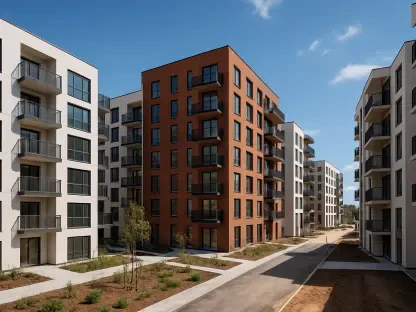New Zealand’s construction industry stands at a pivotal moment, having experienced significant fluctuations over the past years. As 2025 unfolds, the construction sector navigates a turbulent phase marked by an ongoing decline in building consent numbers. This phenomenon not only mirrors the economic and market challenges facing the industry but also raises questions about its future trajectory, particularly concerning residential construction. From a high of $32.138 billion, the annual value of building work consented has decreased to $26.920 billion, with the pace of this decline hinting at an uncertain path forward. The industry, previously bolstered by a robust demand for housing, now grapples with fading momentum. This deceleration points to underlying issues that could prolong the slowdown beyond 2026. The landscape of construction consents affects everything from the number of new homes entering the market to potential changes in housing prices, making it crucial for stakeholders to understand and adapt to these shifting dynamics.
Current Trends in Building Consents
Recent data shows a marked decrease in the annual value of building work consented across New Zealand. This contraction is not isolated to one year but reflects a cumulative decline over several years. In April 2024, the total value of building consents declined by $3.569 billion, while the subsequent year saw a further reduction of $1.649 billion. Such figures highlight a persistent downward trend not only in the monetary value of consents but also in the volume of work that defines the industry’s capacity. This downturn encompasses both residential and commercial sectors, underscoring the broad impact on the construction landscape. The sharp contraction is particularly evident in residential construction, a key segment of the construction industry. Once thriving, it has experienced a stark decrease in the number of new homes consented. From a peak of 50,688 in the period leading to April 2022, the figure tumbled to 33,554 by this year. The significant drop of 17,134 fewer homes consented over three years paints a concerning picture for the sector’s health and its ability to meet housing demands.
The regional analysis provides further insights into the varying degrees of impact across New Zealand. Auckland, a major hub for residential building, has seen its consent numbers plummet dramatically. The region, once buoyant with 21,468 new home consents in 2022, now grapples with a 36% reduction, reaching only 13,748 consents by April. Such declines resonate beyond numbers, hinting at deeper economic issues linked to affordability and the supply-demand balance in urban areas. Wellington has not been immune to this trend, experiencing an even sharper decline. The capital city’s drop from 3,839 new home consents to 1,869 marks a 51% downturn, reflecting an intensified scarcity of new housing options. Meanwhile, Canterbury also faces challenges, with consent numbers dwindling from 8,489 to 6,505, denoting a 23.4% reduction. These figures suggest a widespread recalibration in regional market dynamics, each area adapting differently to the overarching slowdown.
Implications for the Housing Market
The continued slowdown in building consents directly affects New Zealand’s housing supply chain, posing challenges for meeting current and future demands. The decline in new homes consented significantly influences the availability of housing, particularly in urban centers where demand traditionally outstrips supply. Such a dynamic sets the stage for potential increases in housing prices, driven by scarcity and heightened competition among buyers. This shift could exacerbate existing affordability issues, placing pressure on prospective homeowners and renters alike. Economic factors contributing to this scenario are multifaceted. They include rising construction costs, limited supply chain flexibility, and fluctuating interest rates. Collectively, these variables put a strain on both developers and consumers, leading to cautious market behavior that reflects broader economic uncertainties.
The decline in construction activity also has implications for employment within the industry. Fewer building projects mean limited job opportunities for workers, affecting the livelihoods of many individuals reliant on this sector. Additionally, this situation may deter new entrants to the industry, potentially leading to skill shortages in the long term. The interaction between these factors suggests a need for strategic interventions that could support the sector’s rebound. In response, stakeholders must explore innovative solutions that address these pressing challenges. This could involve promoting regulatory reforms, encouraging public-private partnerships to stimulate construction activities, or introducing incentives for sustainable building practices. Such measures could help rejuvenate the sector while aligning it with broader economic and environmental goals. As stakeholders navigate these complexities, there lies an opportunity to reshape New Zealand’s construction landscape to be more resilient and adaptable to future challenges.
Future Outlook and Considerations
New Zealand’s construction industry is at a crucial juncture, having faced notable fluctuations in recent years. As 2025 progresses, the sector is in a challenging phase, characterized by a continued decrease in building consent numbers. This trend not only reflects the economic and market pressures impacting the industry but also casts uncertainty over its future direction, specifically in residential construction. The annual value of building work consented, which once peaked at $32.138 billion, has fallen to $26.920 billion, suggesting a precarious future. This shrinkage not only highlights the diminished demand for housing that once drove the industry but also signals deeper issues that could extend the slowdown past 2026. The decline affects everything from the supply of new homes to potential shifts in housing prices. It’s imperative for stakeholders to understand these changing dynamics and adapt accordingly, ensuring that they are prepared for whatever the future holds in this critical sector.









